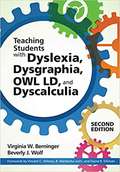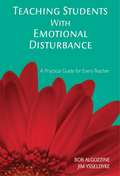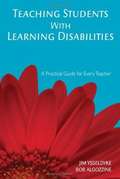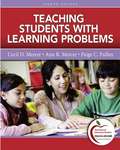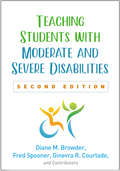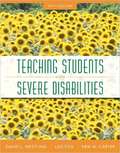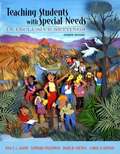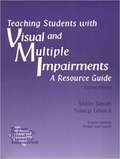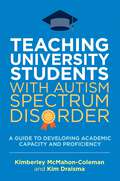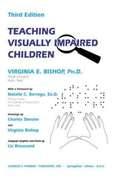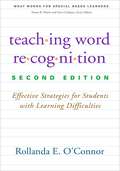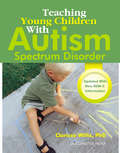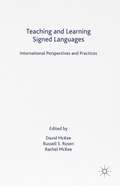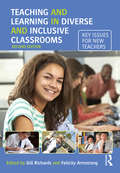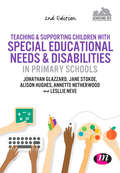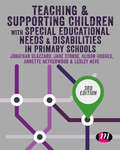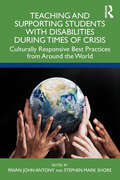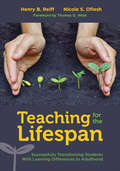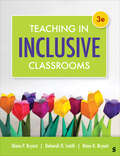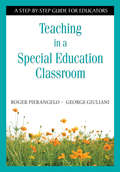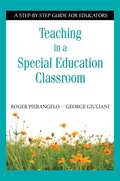- Table View
- List View
Teaching Students with Dyslexia and Dysgraphia, Owl LD, and Dyscalculia
by Virginia Wise Berninger Beverly J. WolfHow can teachers provide effective instruction for students with learning disabilities while meeting the needs of all students? The second edition of this accessible text gives K–12 educators research-based answers, straight from two highly respected voices in the field. The first teacher training text to cover all four learning disabilities that require differentiated instruction—dysgraphia, dyslexia, dyscalculia, and oral and written language learning disability (OWL LD)—this book prepares educators to deliver explicit and engaging instruction customized to the needs of their students. Critical insights from diverse fields blend with lessons learned from actual teaching experience, making this an ideal preservice text and a great in-service professional development tool. <P><P> THE BOOK TEACHERS NEED TO strengthen instruction with current research findings from many fields—including genetics, neuroscience, linguistics, and education help all students (including students with specific learning disabilities) develop oral and written language skills and proficiency with math concepts and problem solving use differentiated instruction to organize their classrooms, routines, and lesson plans uncover both the why and the how of differentiated instruction, so they can adapt their teaching techniques as needed meet Common Core State Standards while addressing the learning needs of individual students apply a specific instructional framework that helps students overcome working memory inefficiencies and related problems create a positive learning environment that promotes intellectual engagement and social emotional development <P><P> WHAT'S NEW: A timely new chapter on using technology for accommodations and explicit instruction * Research Lessons that demystify new findings * Teaching Tips featuring educators' voices of experience * more on in-service preparation for educators on interdisciplinary school teams * guidelines on addressing current challenges in the field * coverage of specific learning disabilities related to math * recommended practices for meeting Common Core State Standards *
Teaching Students with Emotional Disturbance: A Practical Guide for Every Teacher (Practical Approach To Special Education For Every Teacher Ser. #Vol. 11)
by Bob Algozzine Jim YsseldykeValuable insight and sound intervention strategies for addressing the needs of students with social and emotional problems!When a student is inattentive, extremely anxious, or has an outright tantrum in the classroom, ascertaining the exact cause may be difficult, but it is a critical step in reaching and teaching the students who exhibit these behaviors. In Teaching Students With Emotional Disturbance, Ysseldyke and Algozzine show readers how to recognize the cognitive, academic, physical, communicational, and behavioral characteristics of several forms of emotional disturbance and offer specific strategies for responding to anxiety issues, opposition and noncompliance, tantrums, disruptiveness, inattention, task avoidance, and more.Highlights include:* A pretest and posttest to help readers assess their understanding about the origins of social and emotional difficulties and how they are best addressed* Effective interventions and instructional adaptations for students who have emotional problems* Trends and issues currently influencing how students with social and emotional problems are taught* Key vocabulary termsThe authors offer a wealth of information and resources so that teachers can better identify the needs of students with emotional disturbance and help them succeed in the classroom.
Teaching Students with Learning Disabilities: A Practical Guide for Every Teacher
by Bob Algozzine James E. YsseldykeThe characteristics associated with LD, and practical teaching strategies proven to increase the success rate of students both inside and outside the classroom.
Teaching Students with Learning Problems (8th Edition)
by Paige C. Pullen Cecil D. Mercer Ann R. MercerLogically organized, comprehensive, and thoroughly applied, the eighth edition of Teaching Students with Learning Problems contains the resources teachers need to make informed decisions concerning their students with learning or behavior problems. No text on the market offers this many classroom-tested strategies, including activities and games. Unique in its coverage the materials and computer software most appropriate for students with learning problems in every content area, this top-selling text continues to be the most practical and well-researched resource for classroom teachers. New! MyEducationLabmargin notes throughout the text lead readers to online material that will deepen their understanding of important chapter topicsContent area chapters begin with assessment, then discuss the research and methods that work best with students with learning problems, followed by classroom strategies to help every student succeed. Behavior management and affective intervention coverage provides teachers with the tools to help students succeed. New! Response to Intervention coverage throughout chapters explains this important information as it relates to IDEA 2004. Common characteristics of different categories of learning problems help teachers identify problems related to instruction to better choose appropriate teaching techniques.
Teaching Students with Moderate and Severe Disabilities, Second Edition
by Diane M. Browder Fred Spooner Ginevra R. Courtade and ContributorsFor years the text of choice for developing excellence as a teacher of K–12 students with moderate and severe disabilities, this clearly written work has now been revised and updated. Chapters provide step-by-step procedures for designing standards-based individualized education plans and evaluating and enhancing student progress. Methods and materials for teaching literacy, mathematics, science, and social studies are described in depth. The book also describes effective ways to build functional daily living skills. User-friendly features include extensive vignettes and classroom examples, end-of-chapter application exercises, and reproducible planning and assessment tools. Purchasers get access to a Web page where they can download and print the reproducible materials in a convenient 8 1/2" x 11" size. New to This Edition *Reflects important advances in research and evidence-based practice. *Chapter on collaborating with culturally diverse families, plus a stronger multicultural focus throughout. *Chapter on writing instruction. *Two additional chapters on reading and math, ensuring coverage of both foundational and grade-aligned skills. *Increased attention to students with autism spectrum disorder and to uses of technology.
Teaching Students with Severe Disabilities
by Erik Carter David Westling Lise FoxProvides comprehensive coverage of the major issues pertinent to teaching students with severe disabilities―highly useful information presented in way readers can readily understand and apply. KEY TOPICS: Students with severe disabilities: definitions, descriptions, characteristics, and potential; philosophies and practices for teaching students with severe disabilities; collaboration among professionals and paraprofessionals; parents, families, and cultural issues; planning instructional programs for students with severe disabilities; determining instructional goals for students with severe disabilities; teaching students to acquire new skills; teaching skills for generalization and maintenance; evaluating student progress; creating inclusive educational environments; teaching communication skills; providing behavior support to improve challenging behavior; managing sensory and motor systems; providing support for health and medical needs; teaching personal care skills; fostering friendships and recreational involvement; teaching academic skills; teaching community and domestic skills; using assistive technology; meeting the needs of young children; transitioning to adulthood. MARKET: For educators involved in teaching students with severe learning disabilities or moderate and severe.
Teaching Students with Special Needs
by Tom E. C. Smith Edward A. Polloway James R. Patton Carol A. Dowdythe one thing that will remain constant is the commitment to provide all students, regardless of their abilities or disabilities, with an equal opportunity to receive an appropriate education.
Teaching Students with Visual and Multiple Impairments: A Resource Guide
by Nancy Levack Millie SmithResource guide for teachers
Teaching University Students with Autism Spectrum Disorder: A Guide to Developing Academic Capacity and Proficiency
by Kim Draisma Kimberley Mcmahon-ColemanBased on the findings of a five year longitudinal study into the experiences of students with Autism Spectrum Disorder (ASD), this book provides tertiary educators and support staff with practical support for addressing the challenges associated with ASD as they manifest in college and university environments. It explores issues such as: · Interpreting assignment tasks · Unwritten expectations and codes of conduct · Rigidity of thinking · Project planning · Self-monitoring · Multi-tasking and central coherence The authors suggest practical strategies for better accommodating students with ASD in the inclusive classroom. Chapters include case studies of individual students, which provide real world examples of possible issues and successful interventions, making this an essential resource for all those involved in supporting students with ASD in tertiary education settings.
Teaching Visually Impaired Children
by Virginia E. BishopIn this exceptional new third edition, the author has retained much of the practical how to approach of the previous editions, but adds depth in two dimensions: learning theory and the educational process. This book is so comprehensive in scope and complete in detail that it would be the most likely one I could recommend (from the foreword by Dr. Natalie C. Barraga). There is a new chapter on the prenatal and early postnatal development of the visual system, and another entire chapter on gifted children who are also visually impaired information not usually available in other textbooks. One of the most outstanding new sections is a discussion of brain function and its relationships to early development, learning, and visual function. The reader will find practical hints, philosophical rationale explained in simple terms and clear descriptions of the assessment process for students with visual impairments. The relationships between assessments, placements, and programming are described in detail, and provide rationale for best educational practice for visually impaired learners. University faculty, special teachers (TVIs), regular classroom teachers, and families will all find something useful in this new edition. It continues to be a valuable reference for anyone dedicated to helping students with visual impairments achieve independence and realize their full potential. The appendices contain a set of listening games, touch typing lessons, a list of indicators for evaluating gifted programs, lists of assessment instruments and resources, and an updated timeline of major events in the history of education for visually impaired students. A glossary of terms completes the book.
Teaching Word Recognition, Second Edition: Effective Strategies for Students with Learning Difficulties (What Works for Special-Needs Learners)
by Rollanda E. O'ConnorThis highly regarded teacher resource synthesizes the research base on word recognition and translates it into step-by-step instructional strategies, with special attention to students who are struggling. Chapters follow the stages through which students progress as they work toward skilled reading of words. Presented are practical, evidence-based techniques and activities that target letter- sound pairings, decoding and blending, sight words, multisyllabic words, and fluency. Ideal for use in primary-grade classrooms, the book also offers specific guidance for working with older children who are having difficulties. Reproducible assessment tools and word lists can be downloaded and printed in a convenient 8 1/2" x 11" size. New to This Edition *Incorporates the latest research on word recognition and its connections to vocabulary, reading fluency, and comprehension. *Chapter on morphological (meaning-based) instruction. *Chapter on English language learners. *Instructive "Try This" activities at the end of each chapter for teacher study groups and professional development.
Teaching Young Children with Autism Spectrum Disorder
by Clarissa WillisWhat do you do when a three-year-old with autism falls on the floor kicking and screaming? How do you communicate with a child who looks away and flaps his hands? Who can help if you suspect a child in your class has autism? Preschool can be overwhelming for a child with autism. Autism affects how a child communicates, behaves, and relates to others. Teachers need to know what they can do to help children with autism reach their full potential. Teaching Young Children With Autism Spectrum Disorder is a straightforward, easy-to-understand guide to working with children who have autism. It explains the major characteristics associated with autism and helps teachers understand the ways children with autism relate to the world. Each chapter offers specific strategies for teachers to use, including setting up a proactive preschool environment, helping children learn life skills, managing behavior, helping children with autism communicate, encouraging children with autism to play, helping them to get along with others, and working with families. Teaching Young Children With Autism Spectrum Disorder helps teachers connect with all children in meaningful ways, allowing children with autism to learn and grow. Updated with new DSM-5 information.
Teaching and Learning Signed Languages
by David Mckee Russell S. Rosen Rachel MckeeTeaching and Learning Signed Languages examines current practices, contexts, and the research nexus in the teaching and learning of signed languages, offering a contemporary, international survey of innovations in this field.
Teaching and Learning in Diverse and Inclusive Classrooms: Key issues for new teachers
by Felicity Armstrong Gill RichardsThis accessible text focuses on diversity in education and the inclusion of all children and young people in all aspects of the school or college community. It provides an introduction to policy, theory and practical strategies in relation to diversity in education for practitioners, researchers and policy makers. The fully revised and updated chapters discuss recent debates, research studies and current initiatives, particularly relating to teaching and learning, and conclude with key questions for student reflection. Topics include: Inclusive education ethnic and cultural diversity challenging behaviour bullying gender identity and sexuality Gypsy, Roma and Traveller children special educational needs listening to parents religious and cultural diversity disability and human rights children and young people who are refugees or seeking asylum Reflecting on legislative duties, personal values and the importance of listening to the voice of all learners, particularly those who may experience disadvantage or discrimination in educational settings, Teaching and Learning in Diverse and Inclusive Classrooms is a key resource for initial teacher training programmes and professional development courses.
Teaching and Supporting Children with Special Educational Needs and Disabilities in Primary Schools (Achieving QTS Series)
by Jonathan Glazzard Alison Hughes Annette Netherwood Lesley Neve Jane StokoeIf you are a primary trainee, or are training to support children in primary schools, this is your guide to working with children with Special Educational Needs and Disabilities (SEND). We begin by exploring what is meant by SEND in primary schools and go on to cover all you need to know about your statutory responsibilities in school. Current legislation and the Code of Conduct are covered, to give you lots of information about the content you will be working in. The book then examines the range of needs you will encounter in primary schools giving you details information and practical advice. This second edition has been fully restructured and updated to include a new section on the key theory relating to SEND. Exploring theories and theorist that you will need to know about to fully understand how to support children. Also new for this edition is a chapter focusing on the role of the SENCO in the primary school. Finally, the book includes more practical support to help you in the classroom. Checklists to help you to work comprehensively and information about useful resources and outside agencies.
Teaching and Supporting Children with Special Educational Needs and Disabilities in Primary Schools (Achieving QTS Series)
by Jonathan Glazzard Alison Hughes Annette Netherwood Lesley Neve Jane StokoeIf you are a primary trainee, or are training to support children in primary schools, this is your guide to working with children with Special Educational Needs and Disabilities (SEND). We begin by exploring what is meant by SEND in primary schools and go on to cover all you need to know about your statutory responsibilities in school. Current legislation and the Code of Conduct are covered, to give you lots of information about the content you will be working in. The book then examines the range of needs you will encounter in primary schools giving you details information and practical advice. This second edition has been fully restructured and updated to include a new section on the key theory relating to SEND. Exploring theories and theorist that you will need to know about to fully understand how to support children. Also new for this edition is a chapter focusing on the role of the SENCO in the primary school. Finally, the book includes more practical support to help you in the classroom. Checklists to help you to work comprehensively and information about useful resources and outside agencies.
Teaching and Supporting Children with Special Educational Needs and Disabilities in Primary Schools (Achieving QTS Series)
by Jonathan Glazzard Alison Hughes Annette Netherwood Lesley Neve Jane StokoeThis book begins by exploring what is meant by SEND in primary schools and goes on to cover everything trainees and teachers need to know about their statutory responsibilities in school. It then examines the range of needs they will encounter in primary schools with plenty of practical advice along the way. This third edition has been fully restructured and updated to include a new section on the key theories and theorists relating to SEND. Also new to this edition is a chapter focusing on the role of the SENCO in primary school. Finally, the book includes more practical support with coverage of current legislation and the Code of Conduct as well as checklists and information about useful resources and outside agencies.
Teaching and Supporting Children with Special Educational Needs and Disabilities in Primary Schools (Achieving QTS Series)
by Jonathan Glazzard Alison Hughes Annette Netherwood Lesley Neve Jane StokoeThis book begins by exploring what is meant by SEND in primary schools and goes on to cover everything trainees and teachers need to know about their statutory responsibilities in school. It then examines the range of needs they will encounter in primary schools with plenty of practical advice along the way. This third edition has been fully restructured and updated to include a new section on the key theories and theorists relating to SEND. Also new to this edition is a chapter focusing on the role of the SENCO in primary school. Finally, the book includes more practical support with coverage of current legislation and the Code of Conduct as well as checklists and information about useful resources and outside agencies.
Teaching and Supporting Students with Disabilities During Times of Crisis: Culturally Responsive Best Practices from Around the World
by Pavan John Antony Stephen Mark ShoreThis volume offers international perspectives on the disproportionate impact COVID-19 has had on disabled students and their families, serving as a call to action for educational systems and education policy to become proactive, rather than reactive, for future disasters. Each chapter in the book is written by authors with lived experiences across diverse global regions, highlighting the daily life of people with disabilities and their families during the pandemic. Including case studies and practical suggestions, the book demonstrates that culturally responsive practices are essential to successfully support people around the world in their times of need. At the critical intersection of education and disability human rights, this book is important for pre-service teachers, researchers, professors, and graduate students to ensure all students are supported during times of crisis.
Teaching for the Lifespan: Successfully Transitioning Students With Learning Differences to Adulthood
by Henry B. Reiff Nicole S. OfieshYour step-by-step guide to successful transition planning Finally, here’s a practical guide that makes transition planning easier. Backed by the latest research in learning and development, Teaching for the Lifespan provides you with the pedagogical best practices to promote your students’ strengths for life-long success. You’ll benefit from: A deep understanding of the educational, vocational, social, and emotional dimensions of adulthood for students with learning differences Techniques to help students with learning differences develop an awareness of proactive behaviors Strategies to help all learners achieve the demands of the Common Core and high-stakes assessments through Universal Design for Learning (UDL)
Teaching for the Lifespan: Successfully Transitioning Students With Learning Differences to Adulthood
by Henry B. Reiff Nicole S. OfieshYour step-by-step guide to successful transition planning Finally, here’s a practical guide that makes transition planning easier. Backed by the latest research in learning and development, Teaching for the Lifespan provides you with the pedagogical best practices to promote your students’ strengths for life-long success. You’ll benefit from: A deep understanding of the educational, vocational, social, and emotional dimensions of adulthood for students with learning differences Techniques to help students with learning differences develop an awareness of proactive behaviors Strategies to help all learners achieve the demands of the Common Core and high-stakes assessments through Universal Design for Learning (UDL)
Teaching in Inclusive Classrooms
by Diane Pedrotty Bryant Brian R. Bryant Deborah D. SmithTeaching in Inclusive Classrooms uses the research-validated ADAPT framework (Ask, Determine, Analyze, Propose, Test) to help teachers determine how, when, and with whom to use proven academic and behavioral interventions to obtain the best outcomes for students with disabilities. Through clear language and practical examples, authors Diane P. Bryant, Deborah D. Smith, and Brian R. Bryant show how to create truly inclusive classrooms for students who have disabilities and who are gifted through evidence-based practices and hands-on strategies. The Third Edition includes reorganized chapters on Individualized Services and Diverse Learners, new information on the latest court cases and IDEA funds, and revised sections on disabilities. Brand new videos address a wide range of current issues in teaching, including the impacts of COVID on inclusive classrooms. With this guide, educators will be inspired and equipped to effectively teach students with disabilities in inclusive settings.
Teaching in Inclusive Classrooms
by Diane Pedrotty Bryant Brian R. Bryant Deborah D. SmithTeaching in Inclusive Classrooms uses the research-validated ADAPT framework (Ask, Determine, Analyze, Propose, Test) to help teachers determine how, when, and with whom to use proven academic and behavioral interventions to obtain the best outcomes for students with disabilities. Through clear language and practical examples, authors Diane P. Bryant, Deborah D. Smith, and Brian R. Bryant show how to create truly inclusive classrooms for students who have disabilities and who are gifted through evidence-based practices and hands-on strategies. The Third Edition includes reorganized chapters on Individualized Services and Diverse Learners, new information on the latest court cases and IDEA funds, and revised sections on disabilities. Brand new videos address a wide range of current issues in teaching, including the impacts of COVID on inclusive classrooms. With this guide, educators will be inspired and equipped to effectively teach students with disabilities in inclusive settings.
Teaching in a Special Education Classroom: A Step-by-Step Guide for Educators
by Roger Pierangelo George A. GiulianiThese guidelines for special education teachers cover gathering student information, classroom design, meeting with parents, evaluation, assessment, classroom management, instructional interventions, and grading options.
Teaching in a Special Education Classroom: A Step-by-Step Guide for Educators
by Roger Pierangelo George GiulianiDesigned for professionals working in a resource room, self-contained special class, or inclusive setting, this step-by-step guide helps new teachers in special education get their careers off to a positive start and offers experienced teachers supportive information to help improve classroom practice.Special education experts Roger Pierangelo and George Giuliani review all aspects of special education teaching, from how to get to know your students before school starts to writing end-of-the-year reports. Teaching in a Special Education Classroom offers straightforward advice to make the school year more productive for you and your students.
